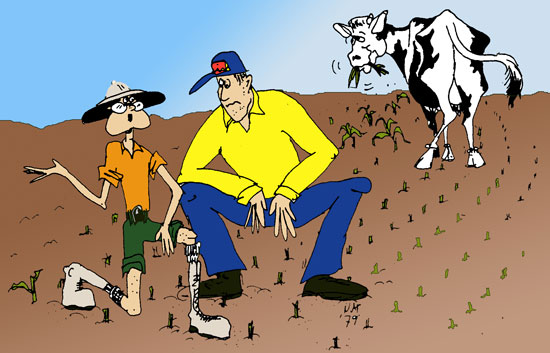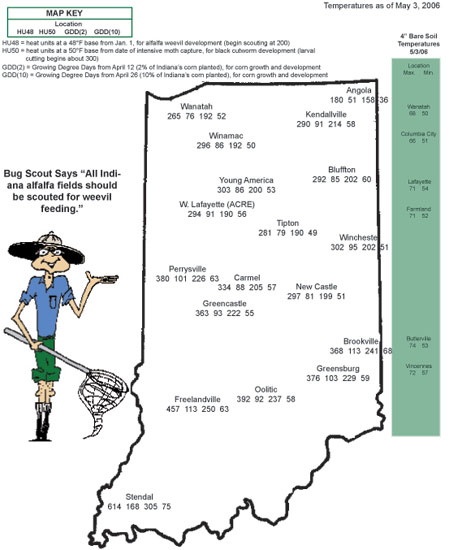Pest & Crop Newsletter, Entomology Extension, Purdue University
Mistaken Identity Leads to Expensive Mistakes – (John Obermeyer, Christian Krupke, and Larry Bledsoe)
- Not all insects, even in the presence of damaged leaves, are impending doom for the field.
- Identification aids (e.g., Corn & Soybean Field Guide) should be accessible and used.
- Two examples below where things in fields were NOT what they seemed.

Globular springtail on corn leaf

White Grubs and cut seedling

Sod Webworm on damaged leaf
While visiting some emerging cornfields in the last week, it has come to our attention that it may be easy to confuse some insects and/or damage with a real threat. Fortunately, correct identification of these look-alikes prevented needless and wasted insecticide treatments. Consider the following examples encountered locally over the last few days.
Example #1, they are round, black and can jump when disturbed. We received a call concerning corn flea beetles infesting 1-leaf corn in a west central county. Our interest was piqued because we didn’t anticipate large numbers of flea beetles this spring (Pest&Crop #2) and the seed in question had been treated with a systemic-insecticide. The small field was up against a tree line, so we reasoned that this may have contributed to successful overwintering of the beetles. However, while walking the field, we didn’t encounter a single corn flea beetle on the leaves. However, we did find globular springtails. Springtails, insect Order Collembola, are small (usually 1/16”-1/8”) insects without wings that move about by “springing.” They are found in almost every habitat (including the North and South Poles!), but are often associated with moist, high organic matter conditions. They are detrivores, meaning the feed upon decomposing plant and animal material. They are not pests, and are actually beneficial in aiding decomposition, much as earthworms do. Admittedly, this was the first time we encountered so many springtails on seedling corn – perhaps because we never looked so closely before. Though they were round, dark in color, and “jumped” from the plant when disturbed, they were definitely not feeding on the corn. Simply…mistaken identification.
Example #2, leaf feeding and cutting of seedlings. What had been a weedy field, was now yellowish 1-leaf, corn. Many emerging plants were leaf damaged, some were cut. This had all the hallmarks of a black cutworm infestation. However, black cutworm development (see “Weather Update”) should not be advanced enough to create the damage seen. A leisurely stroll back to the truck for a digging tool was worth the trip. Found just below the soil surface of damaged plants were wireworms, white grubs, and sod webworms. In other words, several different critters were feeding on the slow growing corn seedlings. The levels of damage seen may have reached a treatable level had black cutworm had been the culprit. A rescue is not possible for wireworms and grubs and iffy at best for sod webworm. At this point, the best solution is to hope for favorable growing conditions for the corn to “outgrow” further damage.
The bottom line, as always: Correct identification is key to economically successful scouting! Happy scouting!
![]()
Black Cutworm Arrival and Development May Coincide With Corn Yet Planted - (John Obermeyer, Christian Krupke, and Larry Bledsoe)
- Black cutworm moths continue to arrive.
- With approximately two-thirds of corn yet to be planted, dmage likely to be higher than previous two years.
- Seed/soil insectices will provide suppression of this pest, NOT control of heavy populations.
Storm fronts originating from southwestern regions of the United States, have blown significant numbers of black cutworm moths into Indiana over the past several weeks. The timing of intensive moth captures (9 or more moths caught over a 2-night period) and subsequent larval development may be a problem for corn yet to be planted.
Refer to the “Weather Update” of this newsletter, where we are tracking heat unit accumulations for insect development, corn growth, and soil temperatures. HU50 is the temperature we use to track the development of the black cutworm from the time of an intensive capture to first cutting/damage. Based on the growth development model, it takes approximately 300 heat units (50?F base) from egg hatch to early 4th instar; this is the life stage when black cutworm larvae begin to cut plants. Some leaf injury may be present before then. Using pheromone trapping of moths and tracking of heat unit accumulations for first cutting is not an exact science, but they do give us a good indication of what to expect. It is not possible to predict if individual fields will be infested.
With areas of Indiana yet to plant a majority of their corn, moths may have found these weedy fields as an ideal egg-laying site. Tillage at, or just before, planting will provide little control of the eggs or newly hatched larvae. Since black cutworm has been a minor pest the past two years, producers may have a false sense of security with the seed-applied insecticides. The lack of damage during these past years has been more of an artifact of record early dates for corn planting, thus outpacing cutworm development and threat. This year is different – a more “typical” planting year, so don’t rely on the seed/soil insecticides to control this pest. Timely scouting and rescue foliar insecticides when necessary are the tried and true approach with this stand reducer. Happy scouting!

![]()
Armyworm, Still Quiet on the Front - (John Obermeyer and Christian Krupke)
We have had some reports from southern Indiana counties that few, if any, armyworm larvae and their damage are being found. Admittedly it is still early and detection is difficult, as larvae would be very small (1/8” or less), light in color, and feeding damage nearly negligible. Moths have been observed in and around fields for several weeks. Black light catches throughout the state are higher than normal, but still much lower than the outbreak year of 2001.
Certainly by mid-May, we will know for certain whether this pest has established in large enough numbers to threaten our grassy pastures and crops. Armyworm damage will first be noticed in lush, thick stands of fescue and/or wheat. Rye cover crops are an attractant for moth egg-laying, and corn no-tilled into this situation are very vulnerable to attack.
We would appreciate your observations of armyworm damage. Please call 765-494-4563. Happy scouting!
![]()
![]()
Bug Scout



